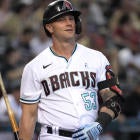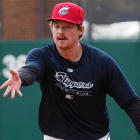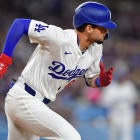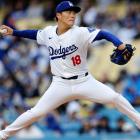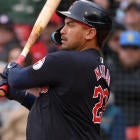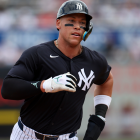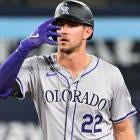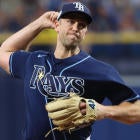
You're not buying players, you're buying numbers. That's one of the enduring messages of Moneyball, and it's even more applicable to Fantasy sports than it was to the early-aughts Oakland Athletics. Because, while there are clubhouse chemistry and other such concerns to consider when putting together a real team, Fantasy Baseball really is just all about the numbers.
Whichever team has the most points wins, at the end of the day. And, while I'll advocate for buying someone fun like Oneil Cruz, ultimately the names you have on your team don't matter, the numbers they put up do. Cruz is fun because he's a massive, 99th percentile athlete who might hit 40 homers and steal 30 bases.
Which is to say, if you can find the same numbers later in your draft as a given player is going, it's probably a better idea to just take the cheaper player. Of course, predicting what's going to happen in a given baseball season is incredibly difficult to do, and it's hard to consistently find inefficiencies in the draft marketplace these days, so finding those kinds of discounts is tough.
But it's what we're here for. I'm leaning on the ATC Projections, available at SportsLine.com (plus my own intuitions) to find five generic brand alternatives to big-name, pricey star players.
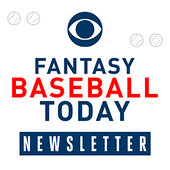
Fantasy Baseball Today Newsletter
Your Cheat Code To Fantasy Baseball
You're destined to gain an edge over your friends with advice from the award-winning FBT crew.
Thanks for signing up!
Keep an eye on your inbox.
Sorry!
There was an error processing your subscription.
Matt Olson (39.6 ADP on FantasyPros.com) vs. Christian Walker (120.8)
This whole thing is about archetypes, and Olson is probably the second-best version of the hulking, slugging first baseman archetype. But there's a lot of room between him and Pete Alonso, and potentially a lot less between Olson and some of the others in that mold. Walker is the go-to comparison here, but I could pick C.J. Cron or Rhys Hoskins or even Anthony Rizzo, too. Olson probably brings a higher floor and ceiling than those alternatives, all of whom are in their 30s, compared to the 29-year-old Olson.
However, Walker put up basically identical numbers last season, and was pretty good in 2019 and 2020 as well – so he's not just a one-year wonder. Olson's 2021 was clearly better than any season of Walker's career, including last, and if Olson gets back to that level after a year of adjusting to new pitchers in the NL, he'll clear this group easily. However, I will point out that Walker actually underperformed his expected stats by a decent amount in 2022 (.359 expected wOBA vs. .346 actual), so there's also room for him to improve on what he managed last season.
ATC Projections
- Olson: .249 average-90 R-35 HR-101 RBI-2 SB
- Walker: .250-77-26-84-2
Gleyber Torres (116.6) vs. Jorge Polanco (148.4)
We're past the point of expecting a return to the elite power numbers Torres put up in 2019, when he took advantage of a barely-trying Orioles squad to the tune of a whopping 13 homers in 18 games. Torres hasn't hit anywhere near that well since then, but he's managed to re-make himself as a pretty solid all-around Fantasy option, thanks in large part to 24 combined steals over the past two seasons. And, in a post-juiced-ball era, his 24 homers are nothing to sneeze at from the shallow second base position.
Polanco is coming off a tough season where he fought through knee tendinitis and ended up playing just 104 games, putting up a .235/.346/.405 line that was a far cry from the career-best numbers he put up in 2021. However, one thing worth noting is that the underlying numbers suggested he wasn't much worse than the previous season, with a .248 expected batting average and .451 expected slugging percentage put him within spitting distance of the previous season's expected stats despite the injury. Assuming he's healthy, Polanco seems like a safe bet to out-hit Torres, and his 11 steals in 2021 suggest he's not necessarily going to trail him too much in that category either.
ATC Projections
- Torres: .258-73-21-71-12
- Polanco: .255-77-22-74-6
Wander Franco (86.8) vs. Amed Rosario (137.6)
The case for drafting Franco remains tied to the upside he showed as a prospect. That's not to say he's been bad as a major-leaguer, but his career .282/.337/.439 line and 13 homers and 10 steals in 153 career games certainly isn't worth a seventh or eighth-round pick. It all looks a lot better when you remember he'll have just turned 22 when the 2023 season begins and he managed a .335/.402/.537 line over 224 games in the minors at a very young age. He showed some real signs of promise before injuries derailed his second season, and if he can start to hit the ball with authority more consistently, there's no reason he can't take a big step forward with the bat.
Of course, if he doesn't, Rosario might just be the better player. Maybe not the better hitter, though even on that count, Franco hasn't necessarily proven he's much better than Rosario, who is a solid bet for batting average and flashes the kind of max exit velocities that suggest there's more upside as a power hitter than he's tapped into so far. Even if he doesn't, however, Rosario has elite speed that makes it fairly easy to project an increase on the 18 steals he had last season, given the new rules set to go into effect this season. Franco's upside is higher, but Rosario has a path to being better than we've seen so far, too,
ATC Projections
- Franco: .286-82-13-69-12
- Rosario: .277-78-11-65-16
Spencer Strider (32.6) vs. Carlos Rodon (41.8)
Strider and Rodon are, in many ways, mirror images of one another. Both are effectively two-pitch pitchers, with Strider and Michael Kopech the only starters last season to rely on their four-seam fastballs more than Rodon. Among pitchers who threw at least 130 innings last season, Rodon's 11.98 K/9 was bested only by Strider's 13.81 mark, and they were No. 1 and 2 in FIP, too. On a per-inning basis, these two look like two of the best pitchers in baseball.
What is elevating Strider's price is his lack of injury history, especially relative to someone like Rodon. Strider had Tommy John surgery before going pro, but has mostly avoided injuries since – he missed a few weeks at the end of last season with an oblique injury, but doesn't really have much else worrisome in his track record. Compare that with Rodon, who has gone on the IL eight times as a major-leaguer, including having had surgery on both his elbow and shoulder back in 2019 and 2017. Since coming back from Tommy John, he's had two IL stints, one with shoulder soreness and once with shoulder fatigue, but he does have one thing going for him that Strider doesn't: He's proven he can handle a full season workload as a starter.
Even including his lone postseason start, Strider's 134 innings in 2022 represent his high point as a pitcher. Rodon has bested that five times as a professional, including a career high of 178 last season. That's no guarantee Rodon will do it again, of course, but I feel like his best-case scenario outcome sees him top 180 innings, and I can't say the same about Strider.
Strider might be the better pitcher, though I'm not convinced there's much of a gap there, honestly. And, while his injury risk might be lower than Rodon's, we've also simply never seen how he'll hold up to a 150-inning workload. Last season, he started out in the bullpen before moving to the rotation, a maintenance program that ensured he would never have to throw too many total innings. It's a risk-reward disparity, I suppose, but in this case, I'm simply not sure Rodon has much less reward or much more risk than Strider.
ATC Projections
- Strider: 157 IP-13 W-3.14 ERA-1.08 WHIP-214 K
- Rodon: 170-14-3.15-1.06-217
Dylan Cease (42.2) vs. Robbie Ray (90.0)
Like the previous pitcher pairing, Ray and Cease are very much mirror images, though in this case there's also a reflection in their performance, too – Ray had his best-case scenario season in 2021, followed by a disappointing 2022, while Cease was mediocre in 2021 and amazing in 2022. In both cases, the best-case scenario is probably at least a bit of a mirage, though I have more questions about Cease repeating 2022 than I do about Ray getting back to his 2021 level.
The thing about Cease's breakout is, it was mostly fueled by something pitchers tend to have less control over: Results on batted balls. Cease's strikeout rate was actually a bit lower, while his walk rate was a bit higher during his breakout season, though both were close enough to call it a draw. What led to his ERA dropping nearly two full runs was his HR/9 dropping from 1.09 to 0.79, while his BABIP fell from .309 to .260. Cease got a lot better at limiting hard contact, dropping his expected wOBA on contact from .383 to .313. He was legitimately better, at least as Statcast measures it.
But the thing is, quality-of-contact metrics are pretty noisy from one year to the next for pitchers, and batted-ball results even more so. Taking a big step forward in that regard doesn't necessarily mean the pitcher's talent level changed. In this instance, I'd give Cease the benefit of the doubt, but I'm also expecting some regression.
Ray actually also saw better results on contact last season, thanks to a new two-seam fastball he started throwing around midseason, and it helped lead to a 2.97 ERA and 135 strikeouts in 118.1 innings over his final 20 starts. He was a different pitcher than the one who won a Cy Young in 2021, but he was still a very good one after a poor start. There's always a fairly narrow margin for error with Ray, who consistently gives up a lot of home runs even when he's pitching well, but the sinker did seem to help in that regard.
Ray has also been a relative model of health, having made 30 starts in three straight full seasons (plus 11 in the shortened 2020), so I'd say he's probably a better bet for a bunch of innings than Cease. Both are good bets for 220-plus strikeouts, too, while there's some risk of a middling ERA with each. So, why pay the premium for the guy coming off the career year?
ATC Projections
- Cease: 180-13-3.51-1.21-218
- Ray: 183-11-3.77-1.19-211













